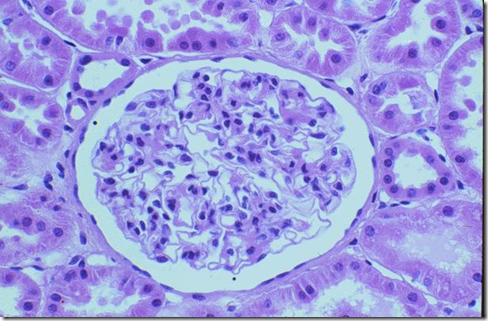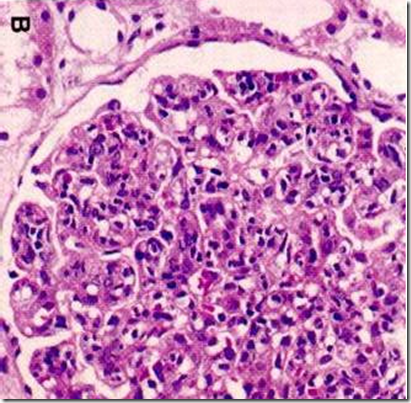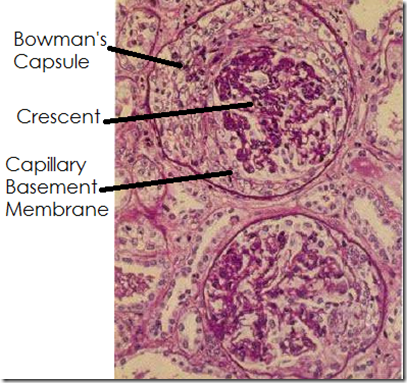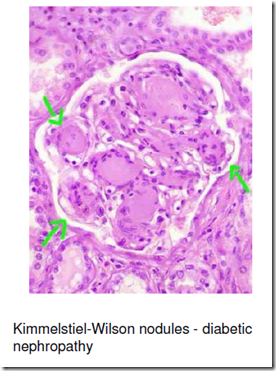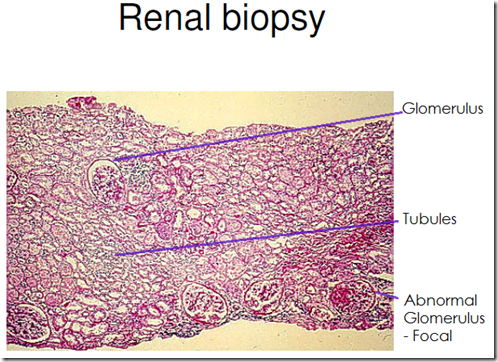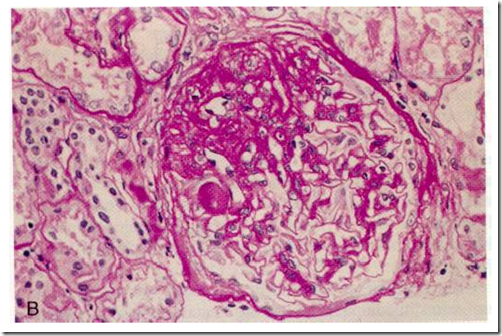Some terminology
Azotemia
- Definition: Raised blood urea nitrogen and creatinine in blood.
- Due to decreased GFR
- Causing biochemical abnormality
- Cause may be:
- Renal
- Extrarenal
- Pre-renal: hypoperfusion (low BP)
- Post-renal: obstruction
Uraemia
- Definition: Azotemia + clinical signs & symptoms
- Cause may be:
- Metabolic
- Endocrine
- Gastrointestinal: Uraemic gastroenteritis
- Peripheral nerves: peripheral neuropathy
- Heart: Uraemic fibrinous pericarditis
Proteinuria
- Definition: Protein in the urine
- can be physiological (after exercise)
Haematuria
- Definition: Blood in the urine
_____________________________________________________________________
5 Clinical syndromes
The syndromes itself does not tell you about the pathology, it just the classification of the signs & symptoms present in the patient.
Any of these clincal syndromes can be caused by primary glomerular disease or systemic diseases/secondary diseases (such as SLE, DM, Vasculitis, Amyloidosis etc)
1) Nephrotic syndrome
- O – Oedema
- *Heavy Proteinuria – more than 3.5 gm/day
- Hypoalbuminuria – less than 3 gm/dl
- Severe generalised oedema
- Hyperlipidemia
- Lipiduria
- Classic example:
- minimal change disease
2) Acute Nephritic Syndrome
- I – inflammation
- Acute onset
- Gross hematuria
- smoky dark urine
- Mild hypertension
- Mild to moderate proteinuria
- as long as not more than 3.5 gm/day (nephrotic)
- Classic example:
- acute post-streptococcal glomerulonephritis
3) Asymptomatic hematuria or proteinuria
- Hematuria or
- Subnephrotic proteinuria
- less than 3.5 gm/day
4) Rapidly Progressive Glomerulonephritis
- Characterised by
- Acute nephritis
- Proteinuria (less than 3.5 gm/day)
- Acute renal failure
- Oliguria/ anuria
- Classic example
- Crescentic glomerulonephritis
5) Chronic Renal Failure
- Acute renal failure
- Oliguria/Anuria
- Recent onset of azotemia
- Classic example: acute tubular necrosis
- Chronic renal failure
- Prolonged uraemia
- End result of chronic renal disease
_____________________________________________________________________
Chronic Renal Disease
Main clinical features:
- Fluid & Electrolytes imbalance
- Oedema –> pulmonary oedema
- due to proteinuria, osmotic pressure decreases, hence more fluid in ISF instead of blood –> kidney excretion
- Hyperkalaemia
- due to increased serum K+ (cant be excreted)
- cardiac arrhythmia
- Metabolic acidosis
- Oedema –> pulmonary oedema
- Calcium/Phosphate metabolism, Bone
- Hypocalcemia
- decreased serum calcium
- Hyperphosphataemia
- increased serum phosphate
- Secondary hyperparathyroidism
- Renal osteodystrophy
- Hypocalcemia
- Haematologic
- Anaemia
- Bleeding diasthesis
- Cardiovascular
- Hypertension
- Congestive Heart Failure
- due to overwhelming fluid
- Uraemia pericarditis
- Urea can’t be excreted
- Lungs
- Pulmonary oedema
- Gastrointestinal
- Nausea & vomiting
- Bleeding
- Oesophagitis, gastritis, colitis
- why?
- Neuromuscular
- Myopathy
- Peripheral neuropathy
- Encephalopathy
- Skin
- Sallow skin
- Pruritis
- uraemic
- Dermatitis
_____________________________________________________________________
Histologic Alteration to Glomerulus
- Hypercellularity
- Basement membrane thickening
- Hyalinisation/Sclerosis of glomerulus
This is a normal histologic picture of the glomerulus (PAS Stain)
1) Hypercellularity
- Increase in number of cells in glomerular tuff
- Due to
- Cellular proliferation of mesangial/ endothelial cells
- Leukocyte infiltration
- Crescent formation
- epithelial parietal cells proliferation
2) Basement membrane thickening
- By light microscopy
- Thickening of capillary wall by light microscopy
- By electron microscopy
- Deposition of amorphous material (often immune complexes) on endothelial/epithelial side of basement membrane
- eg. membranous glomerulopathy
- Deposition of amorphous material (often immune complexes) on endothelial/epithelial side of basement membrane
- OR – Thickening of basement membrane proper
- 3 layers of basement membrane
- Cannot filter at all
- eg. diabetic glomerulonephritis
3) Hyalinisation/ Sclerosis of glomerulus
- Amorphous substance
- Plasma protein
- Capillary lumina is obliterated
- Glomerulus is not functional at all at this stage
- End result of various glomerular damage
Picture above shows nodular sclerosis of the glomerulus.
Glomerular Pathology Terminology
- Diffuse
- all glomeruli affected
- Global
- whole glomerulus affected
- Focal
- portion of glomeruli affected
- Segmental
- only a part of each glomerulus affected
- Mesangial
- mesangium affected
This renal biopsy shows an example of a focal glomerular lesion, which affects only a portion of all glomerulus. As it affects only one glomerulus, all the other glomeruli are normal.
This histologic picture shows a focal segmental glomerular sclerosis lesion. Focal if not all the glomeruli are affected, and segmental because only part of the glomerulus is sclerosed. If the whole glomerulus is affected, then it is global, and if all glomeruli in kidney affected, it is known as diffuse.



